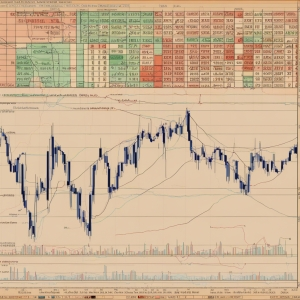Table of Contents:
In today's rapidly evolving digital landscape, the concept of cryptocurrency and blockchain technology is becoming increasingly prevalent. Consequently, strategies for trading these digital currencies also need to adapt. One such innovative approach is the Breakout Trading Techniques. This strategy has the potential to harness maximum profits from considerable price moves.
Introduction to Breakout Trading Techniques
The underlying principle of Breakout Trading is relatively simple: Traders strive to buy an asset when the price breaks above a certain level (known as resistance) and sell when it breaks below a different level (known as support). In essence, this strategy capitalises on the significant price trends that occur when these support and resistance lines are breached.
Nowadays, with increased investment in cryptocurrencies, it's crucial that even beginners understand the basics of Breakout Trading Techniques. Not familiar with these methods? Don't worry, we'll guide you through the fundamentals, give you some hands-on strategies to try out, and discuss the potential benefits and drawbacks of this technique.
Why is Breakout Trading Important?
Understanding Breakout Trading Techniques is essential for several reasons. Primarily, it allows traders to capture significant price movements early in the trend, potentially leading to high profits. Breakout Trading capitalizes on heightened volatility, often resulting from news events, financial reports, or market sentiment changes.
Furthermore, this trading strategy is not confined to a specific market or asset. You could use it in various trading spheres - from equity markets and forex trading to, of course, the increasingly popular cryptocurrency market.
Most importantly, for new traders, this method provides a straightforward structure to follow and clear entry and exit points. This clear approach can help alleviate some of the uncertainties often associated with trading, especially when dealing with volatile markets such as cryptocurrencies.
Pro and Con Analysis for 'Trading Breakouts Strategy'
| Pros | Cons |
|---|---|
| Possibility of high returns | Difficulty predicting breakouts |
| Logical and straightforward strategy | High risk due to potential false breakouts |
| Strategy can be automated with algorithms | Needs constant monitoring and adjusting |
| Provides clear buy and sell signals | Requires a significant amount of patience and discipline |
Understanding Breakout Trading

Getting a grasp of Breakout Trading Techniques requires an understanding of certain fundamental concepts. It all begins with the identification of 'support' and 'resistance' levels in the projected path of a particular security or cryptocurrency. The 'resistance' level refers to the price level which an asset has trouble moving beyond, while 'support' is the level the price doesn't often fall below.
Using historical price charts and technical analysis tools, traders can identify these levels and monitor for potential breakouts. A 'breakout' occurs when the price moves above a resistance level or below a support level with increased volume. This action signifies a possible significant price move in the direction of the breakout.
It is also worth noting that the occurrence of a breakout doesn't guarantee a successful trade. Traders need to corroborate it with other technical indicators and market news to ensure its not a 'false breakout'. Effective Breakout Trading requires a careful blend of chart analysis, intuition, and sound trading decision-making skills. As a result, it can be a highly profitable strategy if implemented correctly.
Key Concepts in Breakout Trading
When it comes to Breakout Trading Techniques, there are several key concepts to be mindful of:
Volume: A crucial indicator in Breakout trading. An increase in trading volume often accompanies genuine breakouts. It provides a confirmation that other traders have noticed the breakout and are also trading based on it. Without a surge in volume, the breakout might be false, leading to potential losses.
Confirmation: This refers to the use of other trading indicators to confirm a breakout. Some traders use moving averages, while others may use trend line indicators. The aim is to validate the breakout and minimize the chances of trading on false signals.
Re-entry: Occasionally, the price may pull back or ‘retest’ the broken level after the breakout. Instead of causing panic, this re-entry can often provide a second opportunity to enter the trade if you missed the initial break. It’s regarded as a sign of a strong breakout.
Stop-Loss Orders: These are predefined orders to sell an asset when it reaches a particular price. A stop-loss order will limit your loss in case of a false breakout. Setting a stop-loss just below the breakout level often results in minimal losses if the breakout was indeed false.
Understanding and applying these concepts efficiently can significantly increase your chances of successful Breakout Trading.
How to Identify Breakouts

The identification of breakouts is a substantial aspect of profitable breakout trading techniques. The process requires attentive market observation and might even entail a bit of trial and error until a practical understanding is acquired.
Primarily, breakouts can be pinpointed by observing two primary elements on the price charts - the price exceeding a defined resistance line for a bullish breakout, or declining below a specified support line for a bearish breakout.
Witnessing a significant spike in volume concurrently with this price movement plays an essential role in differentiating genuine breakouts from false ones. A noteworthy increase in volume implies an increased trader participation, reinforcing the breakout's legitimacy.
Some traders use specific technical analysis tools, such as Relative Strength Index (RSI) or Moving Average Convergence Divergence (MACD), to aid in identifying breakouts. These tools can provide additional confirmation of a breakout, making them invaluable during the evaluation process.
One more commonly used technique is looking for a close beyond the breakout level. Many traders consider a breakout valid only if the price chart shows a closing price beyond the resistance or support. This practice helps avoid false breakouts that can lure traders into poor trades.
Remember, every trader might develop a unique approach to identify breakouts over time, depending upon their individual trading style, risk-tolerance, and experience.
Step by Step Breakout Trading Guide
Your first step in Breakout Trading should be identifying a suitable trading asset. It could be a stock, forex pair, or more likely in the current digital age, a cryptocurrency. Drawing from historical data, ascertain the support and resistance levels of this asset. The resistance is the price threshold that an asset rarely exceeds, while support signifies the price level that the asset hardly falls below. Typically, you'll notice these levels form a 'trading range' – if the price repeatedly reaches but does not surpass these levels, it means support and resistance lines are strong.
Next, vigilantly watch the trading volume of this asset. A rise in trading volume is often a good predictor of a possible breakout. Remember, the more the trading volume, the higher the price momentum. Patience plays a vital part here, as rushing may lead to false breakouts and consequently, financial loss.
Once you observe a breakout, that is, the price surpassing the resistance level or falling below the support level, verify it. Use different indicators and tools to confirm the price movement and ensure it's not a false breakout. Technical indicators like RSI (Relative Strength Index) and MACD (Moving Average Convergence Divergence) can help with this.
If the breakout seems genuine, decide your entry point and set a stop-loss order. The entry point could be as soon as the price breaks the resistance or support level, or you could wait for a retest. A stop-loss order at an appropriate level will protect you from massive losses should the breakout be false.
Following this, establish your target profit. Many traders use the concept of risk/reward ratio here. A common approach is to set a profit target three times the risk (the difference between the entry point and stop-loss order).
Finally, monitor the trade and adjust your stop-loss order if necessary. If the asset price continues to move favorably after the breakout, you can move your stop-loss order to breakeven or even higher to secure some profit. Monitoring allows you to recognise when the trend is ending so that you can get out of the trade at the right time.
This step-by-step guide should set you on the right path towards mastering Breakout Trading Techniques. With patience, diligence, and continuous learning, you can potentially secure substantial profits from this strategy.
Examples of Successful Breakout Trades

Concrete examples can provide crucial insight into how Breakout Trading Techniques work in real-world situations. Here are a couple of scenarios where traders have successfully used this strategy:
Bitcoin in 2017: Possibly one of the most historic breakouts was in 2017 when Bitcoin moved sharply from around $1,000 at the beginning of the year to nearly $20,000 by the end. Traders who identified this major breakout early made extraordinary gains.
Ethereum in 2021: Here, traders experienced a significant breakout when Ethereum started the year under $800 and broke out above its previous high, eventually reaching over $4,000. This breakout gave traders the opportunity to capitalize on a massive price move.
It's important to remember that while these are examples of successful breakout trades, not all breakouts result in massive profits. In many instances, the price may move back below the breakout level, resulting in a loss. As such, always ensure you combine Breakout Trading Techniques with a robust risk management strategy to protect your investment.
Breakout Trading Risk Management
As with any trading strategy, Breakout Trading Techniques also come with their share of risks. Understanding and managing these risks effectively is key to becoming a successful trader. Here are some prevalent risks and how you can mitigate them:
False Breakout: A false breakout occurs when prices break through a support or resistance level, but quickly reverse in the opposite direction. To protect against this, you could wait for confirmation before entering a trade or set a stop-loss order.
Volatility: Increased volatility often accompanies breakouts, leading to sudden price movements. While this can lead to high profits if you're on the right side of the trade, it can also lead to substantial losses. Hence, its essential to monitor the market closely and adjust your positions accordingly.
Lack of Volume: Sometimes, a price breakout can occur without the backing of strong volume, indicating weak support for the price movement. It's generally better to avoid trading these breakouts, as they are more likely to be false.
Slippage: This refers to the difference between the expected price of a trade and the price at which it is executed. High volatility and rapid price movement can lead to slippage. While some slippage is normal, too much could negatively impact your trades. It's advisable to use limit orders or stop-limit orders to control slippage.
In summary, while Breakout Trading can be a powerful technique for trading cryptocurrencies, it's important to manage your risks effectively for better results.
Conclusion
Without a doubt, Breakout Trading Techniques can be effective tools in a trader's arsenal, potentially facilitating substantial returns in volatile markets. Truly successful Breakout Trading demands not just an understanding of the basic concepts, but also a keen eye for identifying genuine breakouts, managing risks, and leveraging supplementary technical analysis tools. It's not a foolproof method and entails its own set of challenges, which makes continued learning and practice crucial.
For beginners looking to delve into the world of cryptocurrency trading, understanding Breakout Trading can serve as a practical, structured approach to navigate the dynamic crypto market. So whether you're a seasoned trader looking to diversify your strategies, or a novice aspiring to make a successful entry into trading, investing time in understanding Breakout Trading might prove to be an investment worth making.
Essential Guide to Trading Breakouts
What is a breakout in trading?
A breakout in trading occurs when the price moves above a resistance level or moves below a support level on increasing volume.
How do you trade breakouts?
You can trade breakouts by identifying key levels of support and resistance, and entering the trade when the price breaks these levels. It's important to wait for the breakout to be confirmed by increased volume.
What strategies can be used to trade breakouts?
There are several strategies that can be used to trade breakouts, including the breakout pullback strategy, the early morning breakout strategy, and the support and resistance breakout strategy.
What are the risks associated with trading breakouts?
The risks associated with trading breakouts include false breakouts, where the price breaks a key level but does not continue in the anticipated direction, and the risk of slippage, where you receive a worse price than expected.
Can you use technical indicators to trade breakouts?
Yes, technical indicators such as the Relative Strength Index (RSI), Moving Average Convergence Divergence (MACD), and Volume can be useful in confirming breakouts and identifying potential entry points.












